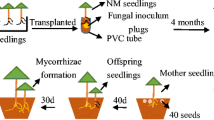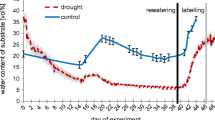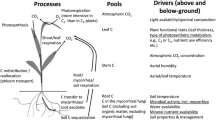Abstract
The purpose of this study was to identify the pathway and sink activity of photosynthate translocation in the extraradical mycelium (ERM) of a Pisolithus isolate. We labelled ectomycorrhizal (ECM) Pinus thunbergii seedlings with 14CO2 and followed 14C distribution within the ERM by autoradiography. 14C photosynthate translocation in the ERM resulted in 14C distribution in rhizomorphs throughout the ERM, with 14C accumulation at the front. When most radial mycelial connections between ECM root tips and the ERM front were cut, the whole allocation of 14C photosynthates to the ERM was reduced. However, the overall pattern of 14C distribution in the ERM was maintained even in regions immediately above and below the cut, with no local 14C depletion or accumulation. We inferred from this result that every portion in the ERM has a significant sink activity and a definite sink capacity for photosynthates and that photosynthates detour the cut and reach throughout the ERM by translocation in every direction. Next, we prepared paired ECM seedlings, ERMs of which had been connected with each other by hyphal fusion, alongside, labelled the left seedling with 14CO2, and shaded none, one or both of them. 14C photosynthates were acropetally and basipetally translocated from the left ERM to ECM root tips of the right seedling through rhizomorphs in the left and right ERMs, respectively. With the left seedling illuminated, 14C translocation from the left to the right ERM increased by shading the right seedling. This result suggests that reduced photosynthate transfer from the host to its ERM increased sink activity of the ERM.









Similar content being viewed by others
References
Abuarghub SM, Read DJ (1988a) The biology of mycorrhiza in the Ericaceae. XI. The distribution of nitrogen in soil of a typical upland Callunetum with special reference to the ‘free’ amino-acids. New Phytol 108:425–431. doi:10.1111/j.1469-8137.1988.tb04183.x
Abuarghub SM, Read DJ (1988b) The biology of mycorrhiza in the Ericaceae. XII. Quantitative analysis of individual ‘free’ amino acids in relation to time and depth in the soil profile. New Phytol 108:433–441. doi:10.1111/j.1469-8137.1988.tb04184.x
Abuzinadah RA, Read DJ (1986) The role of proteins in the nitrogen nutrition of ectomycorrhizal plants. I. Utilization of peptides and proteins by ectomycorrhizal fungi. New Phytol 103:481–493. doi:10.1111/j.1469-8137.1986.tb02886.x
Beiler KJ, Durall DM, Simard SW, Maxwell SA, Kretzer AM (2010) Architecture of the wood-wide web: Rhizopogon spp. Genets link multiple Douglas-fir cohorts. New Phytol 185:543–553. doi:10.1111/j.1469-8137.2009.03069.x
Beiler KJ, Simard SW, Lemay V, Durall DM (2012) Vertical partitioning between sister species of Rhizopogon fungi on mesic and xeric sites in an interior Douglas-fir forest. Mol Ecol 21:6163–6174. doi:10.1111/mec.12076
Beiler KJ, Simard SW, Durall DM (2015) Topology of tree-mycorrhizal fungus interaction networks in xeric and mesic Douglas-fir forests. J Ecol 103:616–628. doi:10.1111/1365-2745.12387
Bending GD, Read DJ (1995) The structure and function of the vegetative mycelium of ectomycorrhizal plants. V. Foraging behavior and translocation of nutrients from exploited litter. New Phytol 130:401–409. doi:10.1111/j.1469-8137.1995.tb01834.x
Bougher NL, Grove TS, Malajczuk N (1990) Growth and phosphorus acquisition of karri (Eucalyptus diversicolor F. Muell.) seedlings inoculated with ectomycorrhizal fungi in relation to phosphorus supply. New Phytol 114:77–85. doi:10.1111/j.1469-8137.1990.tb00376.x
Brownlee C, Duddridge JA, Malibari A, Read DJ (1983) The structure and function of mycelial systems of ectomycorrhizal roots with special reference to their role in forming inter-plant connections and providing pathways for assimilate and water transport. Plant Soil 71:433–443. doi:10.1007/bf02182684
Cairney JWG, Clipson NJW (1991) Internal structure of rhizomorphs of Trechispora vaga. Mycol Res 95:764–767. doi:10.1016/S0953-7562(09)80831-9
Chalot M, Brun A, Botton B, Soderstrom B (1996) Kinetics, energetics and specificity of a general amino acid transporter from the ectomycorrhizal fungus Paxillus involutus. Microbiology 142:1749–1756. doi:10.1099/13500872-142-7-1749
Finlay RD, Read DJ (1986a) The structure and function of the vegetative mycelium of ectomycorrhizal plants. I. Translocation of 14C-labeled carbon between plants interconnected by a common mycelium. New Phytol 103:143–156. doi:10.1111/j.1469-8137.1986.tb00603.x
Finlay RD, Read DJ (1986b) The structure and function of the vegetative mycelium of ectomycorrhizal plants. II. The uptake and distribution of phosphorus by mycelial strands interconnecting host plants. New Phytol 103:157–165. doi:10.1111/j.1469-8137.1986.tb00604.x
Finlay RD, Frostegard A, Sonnerfeldt AM (1992) Utilization of organic and inorganic nitrogen sources by ectomycorrhizal fungi in pure culture and in symbiosis with Pinus contorta Dougl. ex Loud. New Phytol 120:105–115. doi:10.1111/j.1469-8137.1992.tb01063.x
Fransson PMA, Taylor AFS, Finlay RD (2005) Mycelial production, spread and root colonisation by the ectomycorrhizal fungi Hebeloma crustuliniforme and Paxillus involutus under elevated atmospheric CO2. Mycorrhiza 15:25–31. doi:10.1007/s00572-003-0289-7
Hobbie EA (2006) Carbon allocation to ectomycorrhizal fungi correlates with belowground allocation in culture studies. Ecology 87:563–569. doi:10.1890/05-0755
Högberg P et al (2001) Large-scale forest girdling shows that current photosynthesis drives soil respiration. Nature 411:789–792. doi:10.1038/35081058
Kammerbauer H, Agerer R, Sandermann H Jr (1989) Studies on ectomycorrhiza. XXII. Mycorrhizal rhizomorphs of Telephora terrestris and Pisolithus tinctorius in association with Norway spruce (Picea abies): Formation in vitro and translocation of phosphate. Trees-Struct Funct 3:78–84. doi:10.1007/bf01021070
Kennedy PG, Izzo AD, Bruns TD (2003) There is high potential for the formation of common mycorrhizal networks between understorey and canopy trees in a mixed evergreen forest. J Ecol 91:1071–1080. doi:10.1046/j.1365-2745.2003.00829.x
Leake JR, Donnelly DP, Saunders EM, Boddy L, Read DJ (2001) Rates and quantities of carbon flux to ectomycorrhizal mycelium following 14C pulse labeling of Pinus sylvestris seedlings: Effects of litter patches and interaction with a wood-decomposer fungus. Tree Physiol 21:71–82. doi:10.1093/treephys/21.2-3.71
Lian C, Narimatsu M, Nara K, Hogetsu T (2006) Tricholoma matsutake in a natural Pinus densiflora forest: correspondence between above- and below-ground genets, association with multiple host trees and alteration of existing ectomycorrhizal communities. New Phytol 171:825–836. doi:10.1111/j.1469-8137.2006.01801.x
Martin F, Boiffin V, Pfeffer PE (1998) Carbohydrate and amino acid metabolism in the Eucalyptus globulus-Pisolithus tinctorius ectomycorrhiza during glucose utilization. Plant Physiol 118:627–635. doi:10.1104/pp.118.2.627
Marx DH (1969) The influence of ectotrophic mycorrhizal fungi on the resistance of pine roots to pathogenic infections. I. Antagonism of mycorrhizal fungi to root pathogenic fungi and soil bacteria. Phytopathology 59:153–163
Moyersoen B, Beever RE (2004) Abundance and characteristics of Pisolithus ectomycorrhizas in New Zealand geothermal areas. Mycologia 96:1225–1232. doi:10.2307/3762138
Nara K (2006) Ectomycorrhizal networks and seedling establishment during early primary succession. New Phytol 169:169–178. doi:10.1111/j.1469-8137.2005.01545.x
Nara K, Hogetsu T (2004) Ectomycorrhizal fungi on established shrubs facilitate subsequent seedling establishment of successional plant species. Ecology 85:1700–1707. doi:10.1890/03-0373
Nehls U (2008) Mastering ectomycorrhizal symbiosis: the impact of carbohydrates. J Exp Bot 59:1097–1108. doi:10.1093/jxb/erm334
Nehls U, Gohringer F, Wittulsky S, Dietz S (2010) Fungal carbohydrate support in the ectomycorrhizal symbiosis: a review. Plant Biol 12:292–301. doi:10.1111/j.1438-8677.2009.00312.x
Plassard C, Bonafos B, Touraine B (2000) Differential effects of mineral and organic n sources, and of ectomycorrhizal infection by Hebeloma cylindrosporum, on growth and N utilization in Pinus pinaster. Plant Cell Environ 23:1195–1205. doi:10.1046/j.1365-3040.2000.00630.x
Rosling A, Lindahl BD, Finlay RD (2004) Carbon allocation to ectomycorrhizal roots and mycelium colonising different mineral substrates. New Phytol 162:795–802. doi:10.1111/j.1469-8137.2004.01080.x
Rousseau JVD, Sylvia DM, Fox AJ (1994) Contribution of ectomycorrhiza to the potential nutrient-absorbing surface of pine. New Phytol 128:639–644. doi:10.1111/j.1469-8137.1994.tb04028.x
Simard SW, Perry DA, Jones MD, Myrold DD, Durall DM, Molina R (1997) Net transfer of carbon between ectomycorrhizal tree species in the field. Nature 388:579–582. doi:10.1038/41557
Simard SW, Beiler K, Bingham M, Deslippe J, Philip L, Teste F (2012) Mycorrhizal networks: mechanisms, ecology and modelling. Fungal Biol Rev 26:39–60. doi:10.1016/j.fbr.2012.01.001
Smith SE, Read DJ (2008) Mycorrhizal symbiosis, 3rd edn. Academic, London
Söderstrom B, Read DJ (1987) Respiratory activity of intact and excised ectomycorrhizal mycelial systems growing in unsterilized soil. Soil Biol Biochem 19:231–236. doi:10.1016/0038-0717(87)90002-2
Taylor AFS, Gebauer G, Read DJ (2004) Uptake of nitrogen and carbon from double-labelled (15N and 13C) glycine by mycorrhizal pine seedlings. New Phytol 164:383–388. doi:10.1111/j.1469-8137.2004.01164.x
Teramoto M, Wu B, Hogetsu T (2012) Transfer of 14C-photosynthate to the sporocarp of an ectomycorrhizal fungus Laccaria amethystina. Mycorrhiza 22:219–225. doi:10.1007/s00572-011-0395-x
Teste FP, Simard SW, Durall DM, Guy RD, Jones MD, Schoonmaker AL (2009) Access to mycorrhizal networks and roots of trees: importance for seedling survival and resource transfer. Ecology 90:2808–2822. doi:10.1890/08-1884.1
Teste FP, Simard SW, Durall DM, Guy RD, Berch SM (2010) Net carbon transfer between Pseudotsuga menziesii var. glauca seedlings in the field is influenced by soil disturbance. J Ecol 98:429–439. doi:10.1111/j.1365-2745.2009.01624.x
Turnbull MH, Goodall R, Stewart GR (1995) The impact of mycorrhizal colonization upon nitrogen source utilization and metabolism in seedlings of Eucalyptus grandis Hill ex Maiden and Eucalyptus maculata Hook. Plant Cell Environ 18:1386–1394. doi:10.1111/j.1365-3040.1995.tb00199.x
Vogt KA, Grier CC, Meier CE, Edmonds RL (1982) Mycorrhizal role in net primary production and nutrient cycling in Abies amabilis ecosystems in Western Washington. Ecology 63:370–380. doi:10.2307/1938955
Wallenda T, Read DJ (1999) Kinetics of amino acid uptake by ectomycorrhizal roots. Plant Cell Environ 22:179–187. doi:10.1046/j.1365-3040.1999.00385.x
Wu B, Nara K, Hogetsu T (2001) Can 14C-labeled photosynthetic products move between pinus densiflora seedlings linked by ectomycorrhizal mycelia? New Phytol 149:137–146. doi:10.1046/j.1469-8137.2001.00010.x
Wu B, Nara K, Hogetsu T (2002) Spatiotemporal transfer of carbon-14-labelled photosynthate from ectomycorrhizal Pinus densiflora seedlings to extraradical mycelia. Mycorrhiza 12:83–88. doi:10.1007/s00572-001-0157-2
Wu B, Maruyama H, Teramoto M, Hogetsu T (2012) Structural and functional interactions between extraradical mycelia of ectomycorrhizal Pisolithus isolates. New Phytol 194:1070–1078. doi:10.1111/j.1469-8137.2012.04126.x
Acknowledgments
This work was supported in part by Grants-in-Aid for Scientific Research (No. 21248018 and No. 23380080) from the Ministry of Education, Culture, Sports, Science and Technology of Japan.
Author information
Authors and Affiliations
Corresponding author
Rights and permissions
About this article
Cite this article
Teramoto, M., Wu, B. & Hogetsu, T. Pathway and sink activity for photosynthate translocation in Pisolithus extraradical mycelium of ectomycorrhizal Pinus thunbergii seedlings. Mycorrhiza 26, 453–464 (2016). https://doi.org/10.1007/s00572-016-0684-5
Received:
Accepted:
Published:
Issue Date:
DOI: https://doi.org/10.1007/s00572-016-0684-5




